|
|
||
 |
The Clifton Hall GroundsAnd The Octagon Hall |
|
These pages were produced by Roy Mat for his Wilford & Clifton Index in 1997 |
||
 |
The Clifton Hall GroundsAnd The Octagon Hall |
|
Clifton
Hall From The East, 1st Jan 1997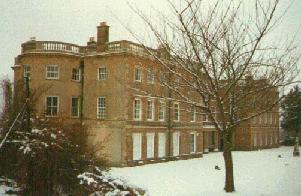
From Watch Tower To University
For almost 600 years the Clifton family lived
at what is now the Grade I listed building, Clifton Hall. It
stands on the summit of a cliff on the edge of Clifton Village over looking
the woodland of Clifton Grove and the meandering River Trent. Its initial
positioning was probably for defense although after generations of modifications
and extensions, the original watch tower fortification has been adapted
to a stately home. The architect John Carr known for his work on
Harewood House, Colwick Hall and the Newark and Chesterfield Town
Halls spent two years extending and modifying the hall until 1780. King
Charles I stayed briefly at Clifton Hall in 1632 as a guest of the 1st
Baronet of Clifton, Sir Gervase Clifton. King Charles occupied a bedroom
at the top of the circular staircase that runs up the east wing of the
house. During his visit the King played bowls with the Baronet. The building
became the Clifton Girls Grammar School in 1958 before taking on its current
role as an administrative building for the Nottingham Trent University
in 1976.
Clifton
Hall Lion, September 1997
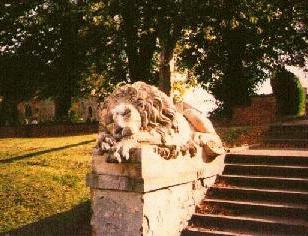 The
Hall Grounds
The
Hall Grounds
Facing the eastern elevation of the hall, at the foot of the first
grass terrace lies two large, weather worn stone lions. The
statues are based on a design in Rome's St. Peter's Square. The
sleeping lions lay seemingly flopped on a wall either side of a set of
steps that lead to the Halls gardens. One of them still has a legible
date of 1840 inscribed on the stand. However one of the lions
is of a much more recent construction. It's a replacement statue
organised by the Clifton Girls Grammar School Headmistress, Miss Heron,
after the original had been damaged. Interestingly, the new lion
is said to be solid stone while the original was hollow. Many people
afterwards tried to identify the genuine article by tapping on each statue
and listening for a hollow echo. Unfortunately, one lion is in very poor
condition, overgrown and with half of its body and head seemingly smashed
away. It's condition has the strange effect of making the lion's contented
smile all the more eye-catching. What an appalling shame after the School
went to so much trouble in the 1950's to preserve the lions, the statues
have been so recently neglected. I also suspect the damaged lion
is the older of the two as the stonework seems to match exactly the aged,
yellow colours of the steep rockery that rises to the next tier of the
garden.
The
Ruined Garden Arches,
September
1997

On the second and largest tier of the garden is a ruined structure built
into the third tier. This would probably once a summer house.
During the period the Hall served as a School the structure
served as an open air theatre. As with the lion statues, it's
a shame the structure has fallen into disrepair.
The Octagon
Hall Domed Ceiling,
October
1997
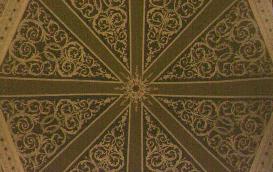 The
Octagon Hall
The
Octagon Hall
From the outside the hall looks a very mundane, characterless brick
shaped building. The exterior doesn't even hint at the presence
of a 70 foot high Octagon Hall of stunning scale and design. It
comes at a complete surprise to the casual explorer that such a majestic,
circular feeling room could be buried within such a rectangular block. The
Octogan Hall is constructed on the site of the original watch tower and
stands in the centre of the building. It resembles a somewhat
undersized, prominently white ballroom with a domed ceiling. It has
detailed, delicate looking symmetrical moldings arranged high on the walls
at different levels. A number of alcoves just above ground level
also display life-size plaster statues of Roman Gods. The moldings
and dome roof have stood the passage of time admirably and appear to be
in pristine, spotless condition. This is quite simply
a very difficult room to photograph due to the scale of the hall and the
height of many of the most spectacular decorations. My pictures
are therefore somewhat dark and do not really do the room justice.
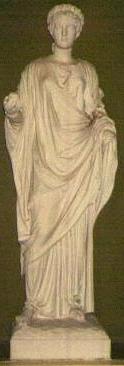 |
Octagan Hall Alcove
Roman Figures |
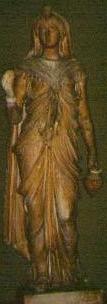 |
|
A High Mounted Crossed
Musket Molding |
The Impressive Marble
Pillared Entrance |
Many Thanks To Tony Ellingham For Showing Me Round The Hall And Making These Pictures Possible